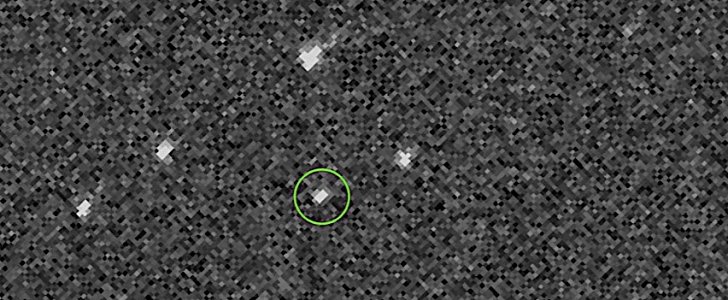As it approaches the asteroid called Bennu for the first ever attempt to bring back to Earth a piece of space rock, NASA’s OSIRIS-Rex caught the first image of the target and sent it back home.
On August 17, NASA kicked off the asteroid operations campaign, meaning all systems are go for approach and study. From a distance of 1.4 million miles (2.2 million km), almost six times the distance between the Earth and Moon, Bennu appears as a pixelated blimp in the photo released this week by the space agency.
“Now that OSIRIS-REx is close enough to observe Bennu, the mission team will spend the next few months learning as much as possible about Bennu’s size, shape, surface features, and surroundings before the spacecraft arrives at the asteroid,” said in a statement Dante Lauretta, OSIRIS-REx principal investigator at the University of Arizona, Tucson.
Bennu is a carbonaceous asteroid with a cumulative 1-in-2,700 chance of impacting Earth between the years 2175 and 2199.
Origins, Spectral Interpretation, Resource Identification, Security-Regolith Explorer, or OSIRIS-Rex, is tasked with orbiting the asteroid in an attempt to determine Bennu’s mass, refine the asteroid’s spin state model, and generate a global shape model.
On December 3, the spacecraft will reach the asteroid and will spend a month or so orbiting its north pole. It will then attempt to land on it for no more than five seconds. Using an instrument called TAGSAM (Touch-and-Go-Sample-Acquisition-Mechanism), it will try and take a piece of Bennu with it for further study.
TAGSAM is an articulated arm equipped with a round sampler at its top. When the spacecraft is touching down, nitrogen gas from a canister will be released to make dust and pebbles rise and enter the sampler.
The equipment on the spacecraft will allow for three repeated attempts to be made at taking a sample of the asteroid. When enough asteroid material has been gathered, it will be deposited in a return capsule. The voyage back home will begin in March 2021.
“Now that OSIRIS-REx is close enough to observe Bennu, the mission team will spend the next few months learning as much as possible about Bennu’s size, shape, surface features, and surroundings before the spacecraft arrives at the asteroid,” said in a statement Dante Lauretta, OSIRIS-REx principal investigator at the University of Arizona, Tucson.
Bennu is a carbonaceous asteroid with a cumulative 1-in-2,700 chance of impacting Earth between the years 2175 and 2199.
Origins, Spectral Interpretation, Resource Identification, Security-Regolith Explorer, or OSIRIS-Rex, is tasked with orbiting the asteroid in an attempt to determine Bennu’s mass, refine the asteroid’s spin state model, and generate a global shape model.
On December 3, the spacecraft will reach the asteroid and will spend a month or so orbiting its north pole. It will then attempt to land on it for no more than five seconds. Using an instrument called TAGSAM (Touch-and-Go-Sample-Acquisition-Mechanism), it will try and take a piece of Bennu with it for further study.
TAGSAM is an articulated arm equipped with a round sampler at its top. When the spacecraft is touching down, nitrogen gas from a canister will be released to make dust and pebbles rise and enter the sampler.
The equipment on the spacecraft will allow for three repeated attempts to be made at taking a sample of the asteroid. When enough asteroid material has been gathered, it will be deposited in a return capsule. The voyage back home will begin in March 2021.

